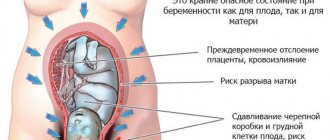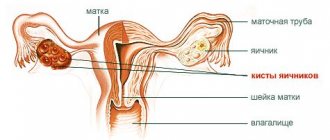Undoubtedly, the main sign of a pregnant woman is a growing belly. It is clear that this is due to the fact that now a small person lives and grows in it, which means that the uterus also grows, water is formed in it, the placenta is formed - the child’s place.
Changes in the uterus, its enlargement, begin already from conception, although they do not yet appear outwardly. They will become visible only in the fifth month, and then a noticeable tummy will appear. This happens for most women, but not all.
Each woman’s body is individual, so for some, obvious signs of pregnancy become visible earlier and their belly grows large, while others can go through the entire 9 months without anyone noticing that they are expecting a child. The woman just gained a little weight – that’s all.
Many mothers worry and worry about why their belly is so small. Will this negatively affect the pregnancy and the health of the unborn child?
Why does the belly grow in pregnant women?
Pregnant women's curves increase due to the growing uterus. The fetus in the womb goes through several stages of development, and throughout the entire embryonic period does not have much weight or height.
In the early stages of gestation, a baby's place is formed, which is attached to one of the walls of the uterine cavity. The shape and characteristics of its growth depend on the place of attachment.
As soon as the fruit reaches medium size and unfolds in a position that is comfortable for it, its external shape will change.
The rounding of shapes comes from the pubic plexus. At first, a slight bulge is located below the navel, and then gradually rises higher.
The size of a pregnant belly directly depends on the gestational age. In the first trimester it is absent, in the second there is a proportional rounding of forms. In the third trimester, it protrudes high, starting in the solar plexus area.
Why the abdominal cavity increases when carrying a baby is completely understandable. The uterus enlarges and bulges forward, pushing surrounding organs to the side. The “pregnant” belly is nothing more than the uterus, inside which the baby develops and grows.
Depending on how the placenta is located and the presentation of the fetus, the shape of the abdomen is acquired, but from external data it is difficult to determine the sex of the baby and its weight.
External characteristics bear the following epithets:
- a round girl will be born;
- sharp - boy;
- small – the baby’s weight will be low;
- big - large fruit.
The data is questionable and not scientifically confirmed.
What to do if your stomach is small
First of all, don't panic. We hope that you regularly visit your doctor, which means that during the examination he measures your abdomen and determines the position and size of the uterus. If the uterus is growing as it should be, then there is nothing to worry about. Everything is going well for you, and your small belly is explained by your individual characteristics.
If the doctor sees that the uterus is not enlarging, he will prescribe examinations: ultrasound, fetal cardiotocography, tests for infections, Dopplerography. Even if you are diagnosed with fetal hypotrophy or polyhydramnios, you should not despair. The main thing is to identify the cause of this condition and take action. With such a diagnosis, you may have to go to the hospital and undergo a course of treatment in order to give birth to a healthy baby.
Factors influencing abdominal growth during pregnancy
The growth of the abdomen and the change in the figure of a pregnant woman is an individual factor. Some mothers in the early stages boast of a rounded tummy, while others do not have one even at 20 weeks of gestation.
What does this depend on, and how to discern a possible pathology.
The change in figure while carrying a baby is associated with a number of reasons. This includes the total number of births, the state of muscle tone, and the weight of the expectant mother.
By body type
The female figure comes in several types:
- “apple” - feminine fullness, in which the external sign of pregnancy may not be noticeable until the very end of the gestational period;
- the “rectangle” of the hips and shoulders are in the same plane, but the growth of the uterus and its external manifestations depend on the muscle layer;
- those with an hourglass and pear figure can boast of rounded shapes from the 14th week of pregnancy;
- with an “inverted triangle” body type (shoulders wider than hips), pregnancy becomes visible a little later, but when measuring parameters in a gynecologist’s office, growth and enlargement of the uterus are noted.
The denser a woman is, the more her position is hidden.
Weight gain is considered a consequence of poor nutrition and the distribution of the fat layer over the muscle layer. A thin body type implies a clear protrusion of the uterus, without unnecessary deposits on the side. However, hormonal levels are an unpredictable thing that can affect the external parameters of a pregnant woman.
By number of pregnancies
In first-time mothers, it is located high. The muscle layers of the uterus are not stretched and hold their shape well.
The more births in the anamnesis, the more closely the abdomen adheres to the womb.
By the number of babies in the belly
Multiple pregnancy has a number of characteristic signs:
- a pregnant woman's belly protrudes forward;
- it is located low above the pubic bone;
- the fundus of the uterus is located at the same level as the solar plexus;
- the skin is blue in color, with red stripes in places.
A large belly means carrying 2, 3 or more babies.
On the nutrition of the expectant mother
The accuracy of pregnant forms depends on the mother’s nutrition.
Many women, with a positive result for hCG, begin to eat uncontrollably. This poses a danger both to the health of the mother herself and aggravates the gestation of the fetus.
Excess body weight due to poor nutrition causes an increase in fat layer. The figure becomes straight, expressionless and graceless.
The buttocks expand, the butt increases in volume. According to statistics, mothers with excess body weight give birth to low birth weight babies.
According to genetic characteristics
A tendency to be overweight may appear during the gestational period.
The fullness somewhat hides the protruding uterus, but over time the forms become refined. In mothers and daughters, the manifestation of pregnancy in the form of uterine growth has some similarities.
Why is my belly small?
There are several reasons for this phenomenon
1. Body features. Women who are tall, have a large build, and have wide hips usually have a smaller belly than miniature, thin, narrow-hipped expectant mothers. After all, there is plenty of space where a mother and baby can comfortably fit.
2. A growing belly is hardly noticeable in women who play sports, since their abdominal muscles are strong and resist stretching for a long time.
3. The same reason - muscle strength - is also responsible for a small belly during the first pregnancy, especially if the expectant mother, taking care of her health (or figure), regularly visited the fitness center, swimming pool, or gym.
4. A small belly in a pregnant woman can be determined by heredity. At the very least, it wouldn’t hurt to ask your mother how her pregnancy went.
5. A small belly may indicate retarded growth of the child, as doctors say - fetal malnutrition. Risk factors for this condition are infections, intoxication of the mother’s body, including alcohol or nicotine, gestosis (late toxicosis), hypertension and some other diseases.
6. Oligohydramnios, or insufficient amniotic fluid, is one of the reasons for a small belly. Oligohydramnios may be a feature of pregnancy, or it may be caused by pathology.
7. Incorrect, or more precisely, transverse position (transverse presentation) of the fetus in the uterus is another reason for a small belly. Usually, before birth, the baby in the uterus assumes a head-down position, and this is how it passes through the birth canal. But sometimes the baby is positioned differently: across or diagonally. In this case, birth takes place by caesarean section.
How the belly grows in pregnant women week by week
During the normal course of pregnancy and gestation of 1 fetus, the growth of the abdomen occurs as follows:
- from the first to the 8th week of gestation, the formation of the baby's place occurs, and the uterus remains in the same size;
- up to the 12th week, the growth of the uterus is so insignificant that it is not noticeable externally;
- from 12 to 16 weeks there is a slight bulging of the lower segment of the anterior abdominal wall;
- from 16 to 20 weeks of gestation, increased growth of the uterus occurs, the placenta takes its place and the child displaces all organs;
- by week 28, active growth of the fetus and, accordingly, the uterus is manifested by external signs;
- from the 30th week until the end of pregnancy, the lumbar region sags, which allows the anterior abdominal wall to protrude even more.
Second trimester
A low belly in the second trimester is a consequence of the ligaments and muscles losing their firmness and elasticity. This is most typical for those women whose births are repeated.
As a result of previous pregnancies, the abdominal muscles are quite stretched, which is one of the reasons for the noticeable enlargement of the abdomen after 16 weeks and sagging in the lower part. This is the main cause of abdominal prolapse, and not low fetal position or placenta previa. Therefore, expectant mothers should not worry too much about this, because with the increase in pregnancy and the gradual expansion of the abdominal cavity, the pregnant woman’s belly will also begin to rise. In this situation, to remove excess load from the spine, experts recommend the use of a special bandage.
Feelings of the expectant mother as her belly grows
Growth is accompanied by various sensations:
- the skin stretches, peels and cracks. Striae appear and it is impossible to get rid of them conservatively;
- displacement of organs leads to constipation, shortness of breath and increased urination;
- the muscle layers are stretched and causes some pain;
- cartilage, groin joints are subject to internal pressure, and discomfort, pain and changes in gait develop.
Norms for tummy enlargement
The dynamics of tummy growth during pregnancy are supervised directly by the leading gynecologist.
With the beginning of the second trimester, every scheduled examination is not complete without measuring the abdominal girth and the height of the uterine fundus. The measurement indicators are entered into the “Exchange Card”. Referring to the data, the doctor focuses and monitors the rate of growth of the tummy, and, accordingly, the dynamics of the baby’s development. The growth of the uterus is observed from the 6th week of pregnancy: the organ is similar in scale to a chicken egg. By the 8th week - the body of the uterus grows 2 times, by the 10th - three times, at the 12th week the uterus increases 4 times and already passes the limit of the pubic bone. At the stage of 14-16 weeks, the body of the uterus extends beyond the boundaries of the pelvis and can be felt by palpation. For a healthy pregnancy, the following norms for the height of the uterine fundus are typical:
- 16 week – 6-7 cm;
- 20 week – 13 cm;
- 24 week – 20-24 cm;
- 28 week – 24-28 cm;
- 32 week – 28-30 cm;
- 36 week – 32-34 cm (peak height of the uterine fundus);
- 38-40 weeks – 28-32 cm (uterus descends).
In case of any deviations from the norm, expectant mothers need to undergo an ultrasound, undergo the necessary tests, if necessary, take a vitamin complex, and in emergency cases, use hospital treatment.
Around the 5th month of pregnancy, the belly becomes noticeable to others. It gradually increases in size until the moment of birth.
- At 2-3 weeks from the moment of conception, the size of the embryo is 2-4 mm, the tummy is not yet noticeable during this period.
- By about 12 weeks, the fetus occupies all the available space in the uterine cavity. The weight of the embryo at this moment is up to 25 grams.
- The belly at 15 weeks of pregnancy may become noticeably rounder. The size of the fruit is 12 mm, and the weight is about 100-120 g.
- By 21 weeks, the size of the fetus reaches 24-26 cm, weight – 350-400 g. From this moment the period of most active growth of the fetus begins.
- Already at 24 weeks, the baby weighs about 500 grams and his height is 30 cm.
- From 36 weeks the fetus is considered full-term. Weight varies from 2 to 2.5 kg.
- At week 40, all formation processes are completed, and the mother’s body prepares for the most crucial moment - childbirth. The weight of the baby can be from 2 to 6.5 kg. These indicators are purely individual; in terms of development, low birth weight children are no different from larger babies. Read more about the norms of fetal growth and weight by week →
The increase in the size of a pregnant woman's belly is associated not only with the rapid development of the fetus inside the uterus. Before pregnancy, the uterus weighs no more than 80 grams. During the process of fetal development, its weight increases 10-14 times; by the time of birth, the organ can weigh 1–1.2 kg.
A change in the size of a pregnant woman’s tummy is also associated with an increase in the volume of anatomical fluid.
- at 3 months – no more than 30-50 ml;
- for 4 – 100 ml;
- 37 week – more than 1 liter;
- immediately before birth, the volumes are reduced - no more than 1 liter.
Even if the belly is small, the expectant mother needs to calm down and go for a consultation with a gynecologist. After an ultrasound and examination, the doctor will be able to determine the reason why the tummy is growing slowly.
Lack of abdominal volume cannot constitute a diagnosis indicating the presence of pathology in any week. There are no methods of prevention. Much depends on the influencing factor. For example, if oligohydramnios and hypertrophy are detected, measures must be taken to eliminate all risks. In other cases, a neat tummy does not prevent the mother from giving birth to an absolutely healthy baby.
A small belly may appear in a second pregnancy, even if it was of normal size the first time. This condition often frightens the mother, but there is no need to worry, because each baby is individual and develops differently.
Signs of abdominal growth retardation
At each scheduled appointment, the obstetrician-gynecologist measures the girth of the pregnant woman’s abdomen and the height of the uterine fundus (UFHR) using a simple centimeter tape. These methods, despite their simplicity, can tell a lot. So, if it suddenly turns out that these indicators have not increased at all or even decreased compared to the previous measurement 1-2 weeks ago, this will alert the doctor. It may even be necessary to conduct an unscheduled ultrasound or other studies of the fetal condition, which could have worsened due to a decrease in the amount of fluid or disruption of placental metabolism.
As a rule, the abdomen of a pregnant woman in a supine position: the girth is at the level of the navel, and the VSD is from the symphysis pubis to the place on the woman’s abdomen where the fundus of the uterus is felt with the hand. There are certain standards that the doctor usually focuses on. For example, at 32 weeks the abdominal circumference should be about 85-90 cm, and by the end of the period these figures are usually 95-100 cm, but these figures can be quite individual. VSDM, in turn, should usually correspond to the period in weeks: at 25 weeks - 25 (±1-2) cm, etc.
Why do I have a small belly at 33 weeks pregnant?
Because you, Fedor, are not pregnant)))) Other answers Thinker (6922) 4 years ago, at 9 months, my stomach was 98 cm, and my daughter was born small 2.800, but healthy - everything is fine! But my son was also small at 30 weeks, and then as he began to grow (4 kg), stretch marks appeared on his stomach. because the subcutaneous layer does not have time to stretch and breaks. Pro (674) 4 years ago I was recently in the hospital, everyone oohed and ahhed! oh why is 30 weeks such a tiny belly! They sent me for an ultrasound, the ultrasound specialist said the baby would be large, apparently, now according to the parameters it corresponds to 31 weeks))) water in moderate quantities. Everything is OK. I return to the doctor who is observing me. says everything is fine! You're probably just a little mother))) that's why your belly is small. Similar questions
How to determine the sex of a child by the shape of the belly:
It’s worth saying right away that it is impossible to determine the sex of a child by the shape of the abdomen: from the point of view of obstetrics, this is in no way scientifically substantiated. Our great-grandmothers tried to determine the sex of the baby in a similar way, when medicine did not yet provide such an opportunity. Their conclusions were based on many years of observations, so whether or not to take them into account is a personal matter for each woman in labor.
- boy
There is an opinion that a pointed and low belly is a sign that a woman is expecting a son. A low belly means that the most protruding part of it is located in the hips and seems to be directed downward.
Another observation: if the boy’s future mother stands with her back to you, her stomach will not stick out, i.e. It will be impossible to determine pregnancy from the back.
- girl
If a woman is expecting a girl, her belly often has a rounded and wide shape, very soft and smooth outlines.
While expecting a daughter, a woman may have an oval, even slightly oblong belly.
Pregnancy will be noticeable both from the back and the front. It is also believed that if a woman becomes the mother of a girl, her entire figure changes, becoming smoother, rounder, and feminine.










